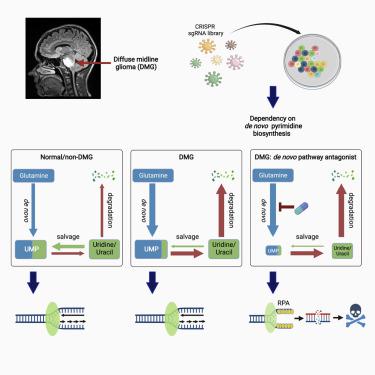Cancer Cell ( IF 48.8 ) Pub Date : 2022-08-18 , DOI: 10.1016/j.ccell.2022.07.012 Sharmistha Pal 1 , Jakub P Kaplan 1 , Huy Nguyen 1 , Sylwia A Stopka 2 , Milan R Savani 3 , Michael S Regan 4 , Quang-De Nguyen 5 , Kristen L Jones 5 , Lisa A Moreau 6 , Jingyu Peng 7 , Marina G Dipiazza 4 , Andrew J Perciaccante 4 , Xiaoting Zhu 8 , Bradley R Hunsel 1 , Kevin X Liu 9 , Sanda Alexandrescu 10 , Rachid Drissi 8 , Mariella G Filbin 11 , Samuel K McBrayer 12 , Nathalie Y R Agar 13 , Dipanjan Chowdhury 14 , Daphne A Haas-Kogan 9

|
Diffuse midline glioma (DMG) is a uniformly fatal pediatric cancer driven by oncohistones that do not readily lend themselves to drug development. To identify druggable targets for DMG, we conducted a genome-wide CRISPR screen that reveals a DMG selective dependency on the de novo pathway for pyrimidine biosynthesis. This metabolic vulnerability reflects an elevated rate of uridine/uracil degradation that depletes DMG cells of substrates for the alternate salvage pyrimidine biosynthesis pathway. A clinical stage inhibitor of DHODH (rate-limiting enzyme in the de novo pathway) diminishes uridine-5′-phosphate (UMP) pools, generates DNA damage, and induces apoptosis through suppression of replication forks—an “on-target” effect, as shown by uridine rescue. Matrix-assisted laser desorption/ionization (MALDI) mass spectroscopy imaging demonstrates that this DHODH inhibitor (BAY2402234) accumulates in the brain at therapeutically relevant concentrations, suppresses de novo pyrimidine biosynthesis in vivo, and prolongs survival of mice bearing intracranial DMG xenografts, highlighting BAY2402234 as a promising therapy against DMGs.
中文翻译:

弥漫性中线神经胶质瘤对从头嘧啶生物合成的药物成瘾
弥漫性中线神经胶质瘤 (DMG) 是一种均致命的儿科癌症,由癌组蛋白驱动,不易进行药物开发。为了确定 DMG 的药物靶点,我们进行了全基因组 CRISPR 筛选,揭示了 DMG 对嘧啶生物合成从头途径的选择性依赖性。这种代谢脆弱性反映了尿苷/尿嘧啶降解率升高,从而耗尽了 DMG 细胞替代补救嘧啶生物合成途径的底物。DHODH(从头途径中的限速酶)的临床阶段抑制剂可减少 5'-磷酸尿苷 (UMP) 池,产生 DNA 损伤,并通过抑制复制叉(一种“靶向”效应)诱导细胞凋亡,如尿苷救援所示。基质辅助激光解吸/电离 (MALDI) 质谱成像表明,这种 DHODH 抑制剂 (BAY2402234) 在大脑中以治疗相关浓度积累,抑制体内嘧啶从头生物合成,并延长颅内 DMG 异种移植小鼠的存活时间,突出显示BAY2402234作为一种有前途的 DMG 疗法。









































 京公网安备 11010802027423号
京公网安备 11010802027423号